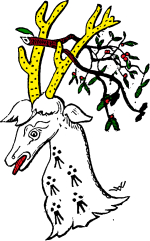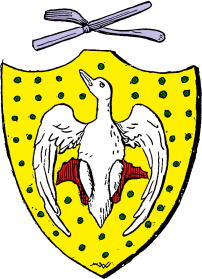HOME
Preface
Introduction
1
2
3
4
5
6
7
8
9
10
11
12
13
14
15
16
17
18
19
20
21
22
23
XIX
CHAPTER XIX.
OF BIRDS, BEASTS, AND FISHES IN BLAZONRY.
APART from the Charges, Ordinaries, Sub-Ordinaries, Common Charges, Artificial and Chimerical Figures, birds, beasts, and fishes occur as frequently in blazoning arms as in a Guildhall Banquet. And in the Heraldic, as in the culinary menu, they have their various values, and have to be described secundum artem.
Beasts and birds come first, and in blazoning savage beasts they should always for choice be represented at their fiercest. A lion or tiger, for instance, should be "rampant." Not that in real life they are pleasant to meet when in that condition, as they then have, according to the Heralds, their tails erected, their mouths open, and their claws, which are not by any means to be considered as the saving clause, out. [N.B.--Advice gratis. When thus met with, sharp's the word and run's the action.] Otherwise they are "salient," leaping. In India, tigers may often be found a-bounding. Leopards and wolves are generally described as "passant," walking along would be a colloquial interpretation of the phrase, and if they were walking a long way off from us so much the better, and Griffins as "segreant."
This rule of ferocious description is, however, not always followed, as wild beasts are frequently blazoned "couchant" or "dormant." Some people say that this latter attitude is too frequently that of the British Lion; but as he usually sleeps with one eye open and the other not shut, he is apt, should anyone tread on his tail or toes, to become rampant, and then things are exceedingly lively for any who get in his way.
The milder animals are represented in Blazonry as nature made them, or as the Heralds imagined them, which is not quite the same thing. As a rule they are supposed, though, in many cases it is only a supposition, to have some connection with the cause for which they were granted. Thus the armorial cognizance of the Temple in London--no connection with Dr. Parker--where lawyers most do congregate, is a lamb, and the connection between a lawyer and fleece, to say nothing of the woolsack, is too obvious to need any further remark.
Every animal should, as a rule, be looking to the right side of the shield, and have its right leg forward. This peculiarity of putting the right or best leg foremost is advisable also in private life, should a mad dog or bull be behind you, wanting in the one instance a sample of your person, or an unfriendly toss in the second.
Another rule as regards the blazoning of beasts is that when the animal is coloured azure the tongue and claws should be gules and vice versâ, unless the description is otherwise expressed in the grant of arms. The chief animals that appear in blue are lions and boars, and perhaps, if we go into the human species, policemen and blue-coat boys. The tongue and claw rule, however, applies to them as well as to the Heraldic sorts.
Now for the birds,as the Alderman said when he helped himself to a brace of plovers, leaving only the dish and the smell to the rest of his family. Birds of prey, like beasts of similar proclivities, are the most sought after--instance falcons and eagles. Both the Russian and Prussian varieties of the latter are given to preying, firstly with an e upon their neighbours (vide France and Turkey passim) and afterwards with an a in their churches.
When birds have their wings on each side of the head, they are said to be "elevated" or "displayed." Bipeds without wings also may sometimes be described as "elevated," and occasionally it ends by their being "displayed" as well--upon a stretcher, with four policemen "portant," en route for the Station.
When, however, the wings of the Heraldic bird are behind its head, or back to back, they are "expanded" or "adossed;" a fanciful arrangement looked at from a practical point of view, but doubtless, armorially, very nice as far as it went.
When the wings are not displayed at all, they are said to be "borne close." Shut up would be the colloquialism for this style, and some interpreters of the science have supposed that this denoted that the bearers of such charges were originally impecunious, and that the non-volant attitude denoted that they had, vulgarly speaking, not a feather to fly with.
If a bird be placed on a shield in an unnatural position, such peculiarity must always be mentioned; thus "Argent, a pheasant proper making bread sauce to be eaten with itself," would be a case in point requiring decided mention.
Fishes are of less esteem as common charges than birds or beasts. Some Heralds declare the cause of this to be that they came after the latter in the order of creation. Hence the term "fishy," as applied to any dubious transaction. They are borne either "upright," "embowed," "extended," or, like a bill of exchange or a cheque, "endorsed." Sometimes, also, they are "fretted" (lobsters boiled alive come very much under that description) or "triangled." Spitchcocked, devilled, or crimped, are not Heraldic terms applied to fishes. If a fish is placed horizontally is it "naiant," and then may be said to be going along swimmingly; it perpendicularly, it is "hauriant."
And that is about all, for the money, that we have to say about birds, beasts, and fishes. Anyone wanting to know more, had better apply to Mr. Frank Buckland, or the Curator of the Zoological Gardens.
XIX
1
2
3
4
5
6
7
8
9
10
11
12
13
14
15
16
17
18
19
20
21
22
23
Preface
Introduction
HOME
Build: 2019/04/20 14:20:08.59+0900(JST)




